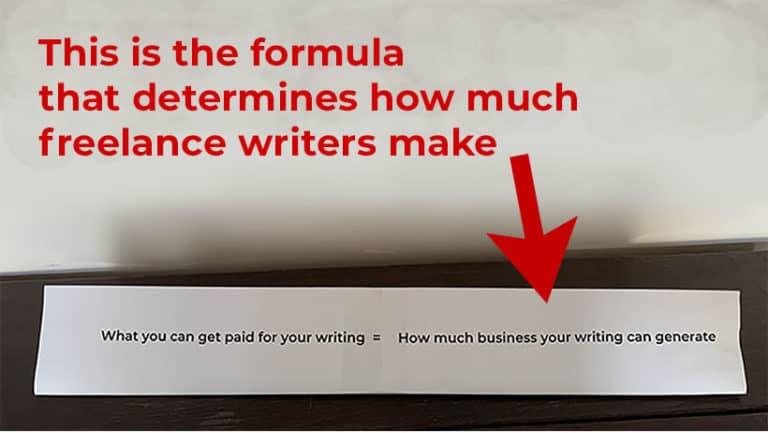Freelance Writing Samples: How to Get Your First Clips
Creating freelance writing samples – also known as “clips” – is one of the biggest hurdles for new freelance content writers. It’s also a common problem for experienced content writers who want to pivot into a new niche.
In this post, we’ll walk through everything you need to know about how to create and publish writing samples your dream clients will love. You’ll finish this post knowing how to create some of the most valuable assets a writer can have.
First, two definitions. While the two terms – writing samples and clips – are often used interchangeably, they do have different meanings.
- A writing sample is typically something you’ll submit for a job application.
- A clip is an article, blog post, or any other piece of content you wrote and that has been published.
When are writing samples requested?
Writing samples are most often requested as part of an application for a full-time job, but they can also be requested as part of other types of applications, like a college application.
Writing samples can also be requested when a writer is applying for either a part-time or a full-time writing position, and they can even be requested for short-term freelance writing projects.
All about clips and bylines
Clips are one of the most precious business assets a content writer can have.
The term “clips” comes from journalism and magazine writing. It traditionally refers to published pieces of content that have a writer’s byline.
A more narrow definition of clips might only include pieces that have been published after an editor reviewed them, so things like magazine and newspaper articles. A wider definition would include any piece a writer has published themselves, like articles or blog posts published on their website or on Medium.com.
But when someone in publishing refers to clips, they almost always mean (or assume) that these are freelance writing samples with the writer’s byline.
What’s a byline?
A byline is where the publisher acknowledges who wrote the article.
In journalism, academic writing, and in creative writing, bylines are always… accurate. It would be a scandal in academia for someone to publish an article or a book that said they wrote it when actually they paid someone to write it for them.
In business writing, the “accuracy” of bylines is very different. By some estimates, 60-80% of the bylines in business publications weren’t actually written by the person whose name is given the byline.
So all those columns on Forbes, and elsewhere in the business press? Most of them were not actually written by the person who gets the byline. They were written by someone called “a ghostwriter” – usually a freelancer who is willing to give up getting the byline, either in exchange for a little more pay, or just so the freelancer can get the work.
A classic example of this is in a trade magazine or in any other type of business magazine, where people from the “C-Suite” have a column or publish an article. (C-Suite refers to people with titles like “Chief Marketing Officer (CMO),” “Chief Financial Officer, (CFO)”, etc.)
90% of the time, the executive who got the byline did not write the article. Someone else wrote the article for them.
Content writers get very used to not getting a byline for their work. Or, they get very used to having someone else get a byline for something they wrote.
If they write for a content mill, an SEO agency, or a content marketing agency, they may never even know where the content they wrote ended up being published.
So, what does all this talk of bylines have to do with freelance writing samples? Because most content writers have quite a few really strong, published writing samples that don’t have their byline on the piece. And so the question comes up:
“Can I use pieces I wrote that don’t have my byline as writing samples?”
Here’s the short answer:
- You can, but it is marginally unethical.
- If you do share the pieces, do NOT do so publicly unless you have permission.
- Even if you do share the ghostwritten freelance writing samples privately, do it as infrequently as possible, and get permission first.
So that’s all the background about freelance writing samples, bylines, and clips. Now let’s talk about getting you some clips that you can use to attract great clients.
How do I get my first freelance writing samples?
At first glance, not having clips can seem like a Gordian knot: You need writing samples to get work, but if you haven’t gotten any work, how are you going to get writing samples?
Fortunately, it is possible to get excellent writing samples without having any to start with. It’s not even all that hard.
You just publish your first freelance writing samples yourself.
This does require you to do a bit of free work, but it’s not a lot of work, and it’s definitely worthwhile work.
Simply having a few good writing samples can make the difference between writing for 2 cents per word or 20 cents per word. And that is not an exaggeration. And you can’t even get work on the better content services without clips.
So how do you go from having no writing samples to having enough writing samples? You just have to take it in steps. But before I show you how to get your first clips published, let’s talk about what makes for a “good” clip – or even a great clip. Because not all clips are created equal.
Not all clips are created equal
Some clips will get you clients. Some won’t.
The sort of clips that will get you clients are clips that are similar to the content your target clients are already publishing. So if you are trying to write for fintech companies, they aren’t going to want to see your parenting articles.
[Harsh truth warning]
Your freelance writing samples about parenting, or travel, or gardening will not reassure prospective clients that you can actually do the writing they need done – unless your writing samples are related to their industry or business.
Even if your parenting articles are extremely well-written, that’s not going to woo a potential fintech client. They assume you know how to write well. You’re the writer, after all. And no offense, but there are a lot of writers available for them to hire.
They are hiring you for the combination of your writing skills AND your understanding of fintech.
So that’s why these are NOT the type of freelance writing samples or clips that are going to get you clients:
- Even really nice magazine clips about an unrelated topic
- Your romance novel, or your science fiction novel, or your historical novel
- A blog post you wrote that’s super personal and about something that is tangentially related to their niche
You get the idea. Clients need a very specific type of writing that communicates their messaging to their customers. They do not want to hire James Joyce. Or Hunter S. Thompson. Or Leslie Lovelace, romance novelist.
So let’s get specific about how to create writing samples your prospective clients will love.
If you want, I have a worksheet that will walk you through how to access your target clients’ content.
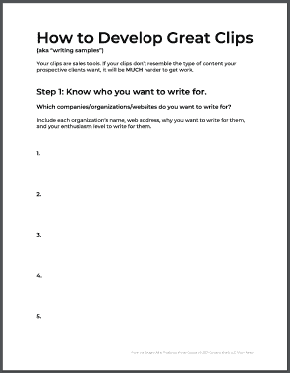
It will show you:
- how to analyze the content of five sites you want to write for
- how to develop content ideas for those sites
Or you can follow along with the instructions here.
How to create content writing samples – aka “clips”
1. Know who you want to write for.
The first part of this is to know your niche.
The next part is to identify at least three dream clients in your niche.
The worksheet has room for five dream clients. You could do more than five, but there’s a risk of analysis paralysis with that, so try to keep the list short. You only need five recurring clients, even as a full-time content writer, so there’s no need to go crazy with research.
2. Become familiar with your target clients’ content.
Answering these six questions will give you x-ray vision about your target clients’ content. You don’t have to do a full content audit here. Just look at content they’ve published in the last six months, or in the last year if that’s manageable.
- What topics or themes are they covering?
- What voice is their content in?
Is it really dry? Feisty? Do they use terms only millennials and Gen Zers would understand? Is it corporate?
- How do they use images?
What type of images do they use – animated GIFs? Charts and graphs from research studies? “Stock photos”?
- Which audiences are they writing for?
Sometimes a piece of content will mention the target audience directly in the article. For instance, “this is something all agency owners struggle with.” Other times it may not be as obvious.
You can also look at other parts of the company’s website to discern who their target audience is. They may actually mention this on their home page, too, like “Activewear for moms,” or “a CRM for small business owners who don’t want to fuss with complex systems.”
- What’s the “worldview” of their content?
Ever heard of “underlying beliefs?” For people, they can be things as broad as “People are inherently good,” or “Getting a college degree is always a good thing.”
Companies have worldviews like this, and the content they publish should reflect those beliefs.
Some companies will come right out and say, “We believe [core belief].” Like, “We believe software should be easy to use” or “We believe clothes should be attractive AND comfortable.”
- What assumptions does their content make?
This is the “other side of the coin” to a company’s worldview. It will tell you more about what to leave out or not say than it will tell you what to say. So, for an expensive clothing manufacturer that’s selling t-shirts for $100 each, there’s an assumption that $100 t-shirts are no big deal.
Don’t get too carried away with analyzing any of this. There’s a reason the handout for this exercise only allows one page for each client. I’ve gone into detail here because I want to explain this clearly enough that you don’t struggle with the worksheet.
Just do take the time to do this exercise – it will give you a deep understanding of your target companies’ content. It will help you create far better clips, and that will make you much more likely to get hired.
3. Find three topics each client hasn’t written about, but should.
These should be topics your client hasn’t written about in the last 18 months or so. You could reduce that down to within the last year if your client publishes a lot of content, but the time frame is flexible.
The number of topics you identify is flexible, too. If you see five really important topics that are directly tied to the company’s products or services, write those down. I only asked for three because it’s enough to work with but not overwhelming.
Do put your business hat on while you’re deciding what this website “should” include. You might want to go to some of their competitors’ sites and see what they’ve been publishing in the last three months. Or go to a trade magazine’s website or to a consumer magazine’s website and see what they’ve been publishing.
This research only takes 10-15 minutes, but it will give you an idea of what other content managers think are important topics. Sometimes, writers pick topics that may be personally important to them, but are things that a marketing manager would probably pass on.
4. Write your clips about those topics.
At last! Now you can write your clips. But do you see how radically better dialed in your clips are going to be now? You’ve got your topics picked, you know exactly what length, voice, and mindset the clips should be written in. You’re about to write clips that are SO much more in line with what a content marketing manager would want.
Write 1-2 clips as if they were going to be published on those websites. As if you already had them as clients and are writing a paid post for them. Those are the types of clips that get clients.
5. Make sure your clips are ready to publish.
In other words, make sure your clips have no mistakes in them.
Before you show these writing samples to anyone, much less a prospective client:
- Run them through the free version of Grammarly. This will catch a lot of errors.
- Run them through the free version of the Hemingway App. Aim for a reading level of 7th-grade or less. Please understand that this does not mean you should “dumb down” your writing; what you are doing by writing at a 7th-grade level is making the sentences clearer so they are easier to read. Avoid big words and complex sentence structures.
- Read your writing sample out loud. This is a great way to know if you have any awkward sentences.
- Add a subheader every 300-400 words or so. Extra credit if your subject headers occasionally have a relevant keyword in them.
- Instead of having long lists broken up by commas, use bullet points once or twice in the article. Bullet points break up the text so it looks easier to read, and bullet points are much easier to scan.
- Include at least one image in your 1,000-word sample, and preferably 2-3 images. Don’t break copyright laws with your images. Unsplash and Pixabay are great sources of public domain images. Images that are examples are especially helpful to readers. It’s fine to use an image if you link back to the site where you found the image on.
- Add 2-3 links to cite information in your article. For instance, if you’ve written, “the economy was up dramatically until February 2020,” consider including a link to an authoritative source that backs that information up. In other words, try to avoid just sharing your opinion; cite facts and authoritative sources. It’s especially helpful if you cite industry sources.
- Break up your text so that no paragraph is more than six or seven sentences long. Many writing experts recommend paragraphs be even shorter, like five sentences or less.
- Use examples where you can. People love examples. Examples anchor the ideas you’re talking about.
That’s a very high-level way to review the quality of an article or blog post, but it’s a good start. If you’ve done all this with your new writing samples, you have something worth showing someone else.
Three ways to publish your first content writing samples
Let’s start with the best way:
1. Write an article on LinkedIn.
LinkedIn is one of the best portfolio sites available to freelance writers, though most of us don’t think of it that way.
Adding an article to LinkedIn’s publishing platform is incredibly easy. From the “Home” screen of your LinkedIn account, just click the words “Write article” in the top center pane.
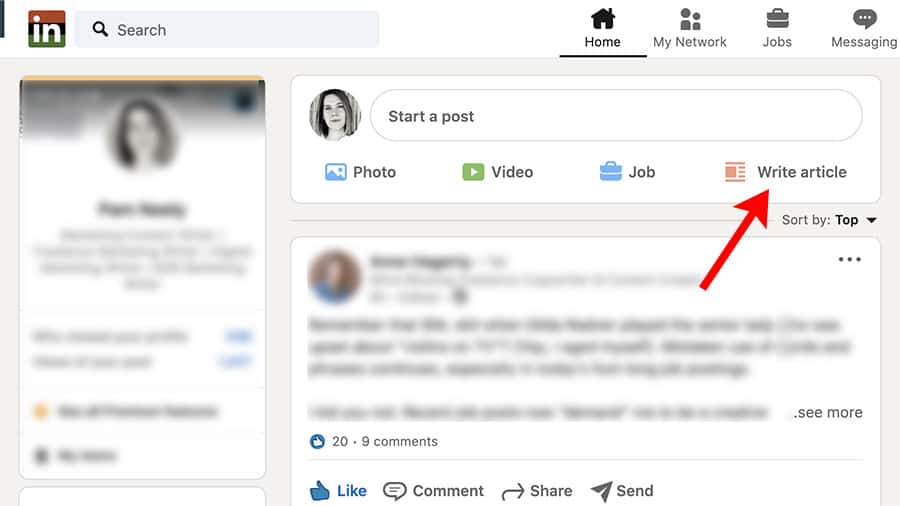
You’ll immediately be brought to a page like this, where you can start typing your writing sample. You can also paste in a writing sample from another program if you prefer to write someplace else besides the LinkedIn articles screen.
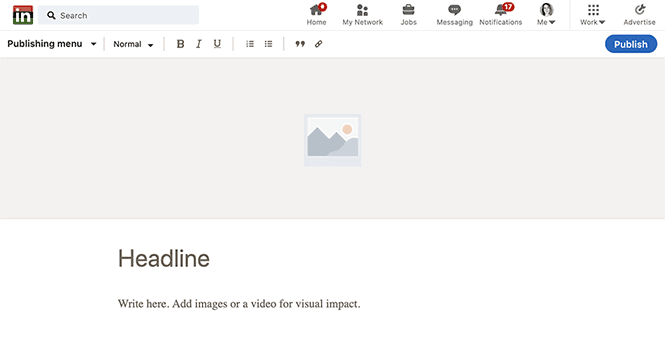
This interface lets you do all the things a Word doc or a WordPress blog page would let you do. You can add links, images, quotes, add bullet points, numbers, italics, bold – all the usual things. You can even add a header image for your post. LinkedIn recommends the cover image to be either a .jpg or a .png 744px wide and 400px tall.
As soon as you’ve typed in a few words or pasted in a few words, LinkedIn will save your article. Look in the upper right-hand corner for the green “Saved” notification.
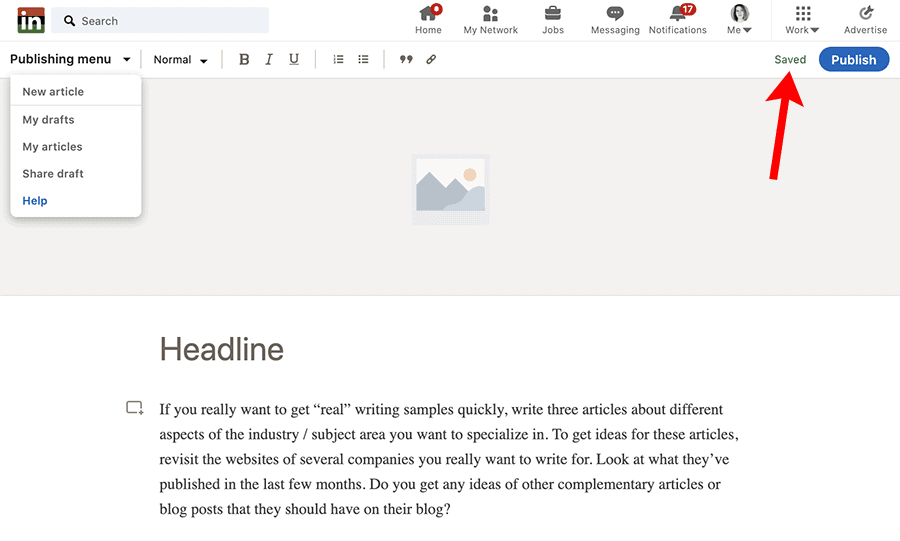
Once your words are saved, you can also click on the “Publishing menu” in the upper left. Click “My drafts” and you’ll see all the drafts you’ve created. As soon as a document is saved, it’s saved in the drafts area. You don’t have to take any action to save your articles in LinkedIn – the system saves them for you every few seconds.
Once you’re ready to share your new writing sample with the world, just click publish.
Don’t forget to add the new article to the “Featured” section of your LinkedIn profile.
The articles you publish on LinkedIn are actually likely to get more traffic than writing samples posted on your own website, or on a Contently-style portfolio. And even if you have your own website and plenty of freelance writing clips, add a few to LinkedIn and link to them in your profile.
If your clips are correctly done, you can get work from them.
2. Publish a post on Medium.com.
Medium is a world unto itself for writers. There are even writers who make money from the work they post on Medium, though most only make a couple of dollars.
While Medium isn’t great as a revenue stream, it is an excellent place to post your work. And even if you originally published your work on LinkedIn or your blog, I would encourage you to also publish it on Medium. More about that below.
For our purposes, we just want to get you another place to publish your work. So head over to Medium and click the “Write” link in the upper right-hand corner.
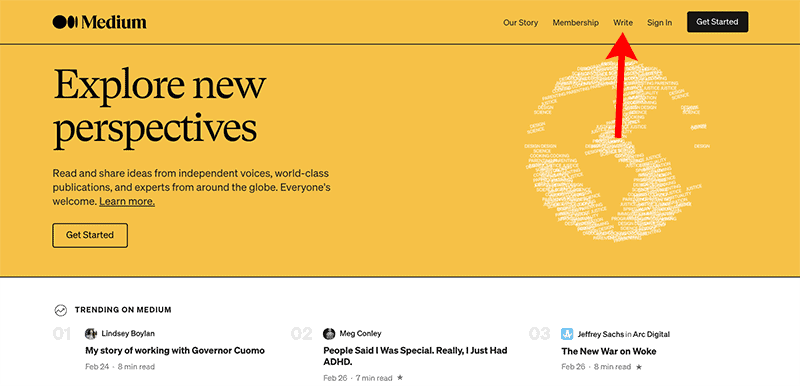
That will bring you to Medium’s “Creators” page. This is what it looks like as of now:
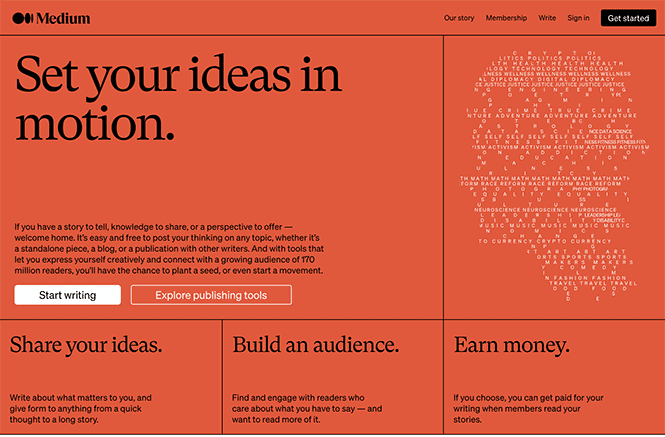
If you click on the “Start writing” button, you’ll be asked to create an account. Once you’ve confirmed your email address, they’ll ask for your name, and then you’ll see a page like this:
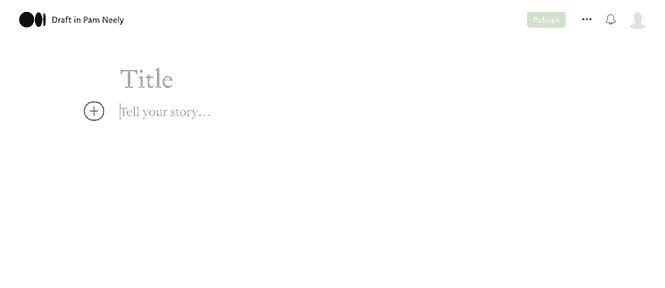
Medium autosaves like LinkedIn does, so don’t worry about saving your work. And once you’ve typed in even a couple of words, that pale green “Publish” button you see above will turn to dark green, and you’ll be able to publish.
If you click the three dots just to the right of the green publish button, you’ll see these options:
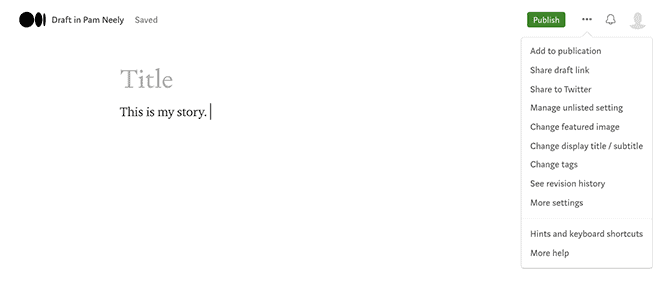
And if you click your profile image (the grey hard icon), you’ll get these options:
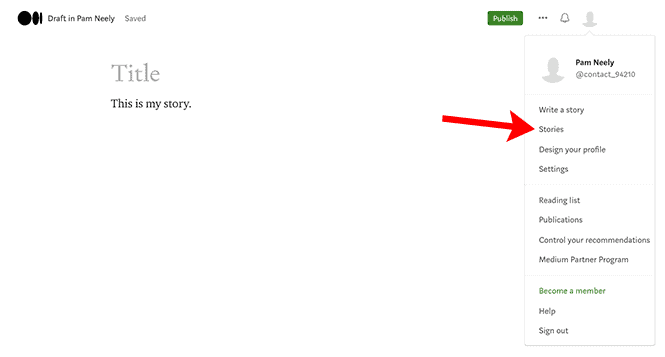
If you’ve already got an article published somewhere else that you want to “import” into Medium, click “Stories” from the selection above.
You’ll be brought to a page that looks like this:
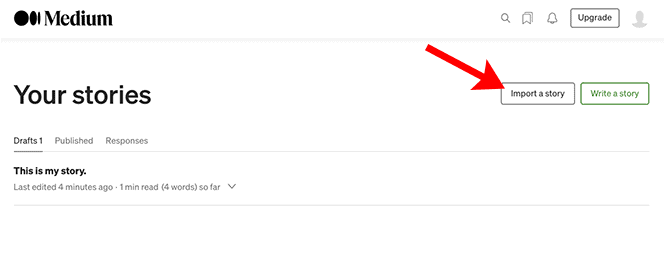
Click that black “Import a story” button to import your article from a LinkedIn article, a WordPress post, or from almost anywhere on the web.
Medium does an excellent job of importing articles, but you should still review everything you import just to make sure something strange hasn’t happened. In the example above, you might have noticed the article title ends with “| KoMarketing”. That’s because Medium pulled the exact page title tag from the website. No big deal, but the article title needs to be edited so “| KoMarketing” doesn’t show.
Medium also added some extra line breaks below all the subheaders in the article, so you’ll need to go in and close those up.
Note that Medium does one other nice thing for you: It adds a link back to the original source of the article:

This is good for SEO and to drive people back to a site where they can learn more about you, like your website or your LinkedIn profile.
3. Post your writing samples to your own website or WordPress.org
If you’ve got your own site either on your own domain (www.yourname.com) or on WordPress.org, you’ll know how to post articles there, so I won’t include instructions here for how to do that.
What you should know is that it is okay to republish articles from your site over on LinkedIn and Medium.com. Especially if you include a link back to your site at the bottom of the articles, and especially if you wait a week or so after you’ve published them on your site to publish them on LinkedIn or Medium.
How to get “more professional” freelance writing samples – clips that have been reviewed by an editor or that have been written for a company
Approach #1: Ask to write for a company.
This can feel a little uncomfortable to do, but summon up your courage and reach out to a few small businesses in your niche.
Ask them if they would like a free piece of content written for their website. Be careful to only ask companies that are related to your target subject area. Ask more than once… it may take at least three queries for them to say yes.
If there’s no appropriate company in your town, reach out to these businesses via email.
Send out about ten of these and you’ll probably land at least one or two new writing samples. If you don’t hear back from people within 3-4 days, send a follow-up email.
If you still don’t hear back from them after a week has gone by since your second email, send a third and final email just to check in.
Business owners are busy, and the content on their websites is not usually their top priority. Just be persistent and polite. But after email #3, stop and try a different company.
Approach #2: Ask to write for an industry publication.
Almost every industry and niche has a magazine/publication. Search for “[your industry] magazine” to find one in your niche.
When I searched for “gardening industry magazine,” I got these results:
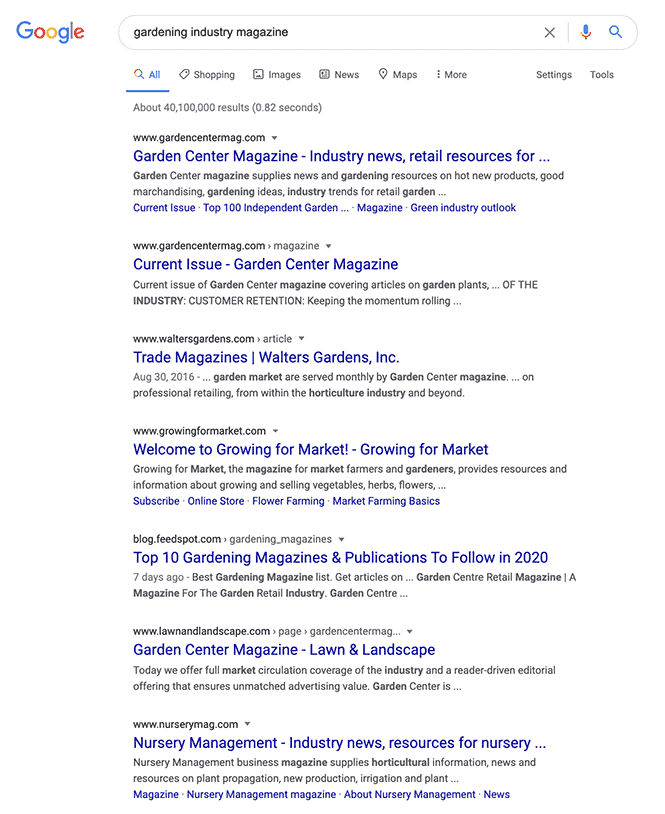
Find results like this for your niche, then review each publication. Can you find an Editor or Managing Editor’s contact information? If you can, then send them an email similar to the one we sent to the company above. Don’t send more than seven or so at a time because you only need a couple more freelance writing samples. And do follow up with the same sequence as described above.
Approach #3: Ask to write for an industry organization.
Every industry has a few magazines, but it will also have a few industry organizations. These are usually professional memberships that offer training, marketing, and networking opportunities. These sorts of organizations almost always have a blog or even a print magazine.
Here’s what turned up when I searched for “gardening industry organization.”
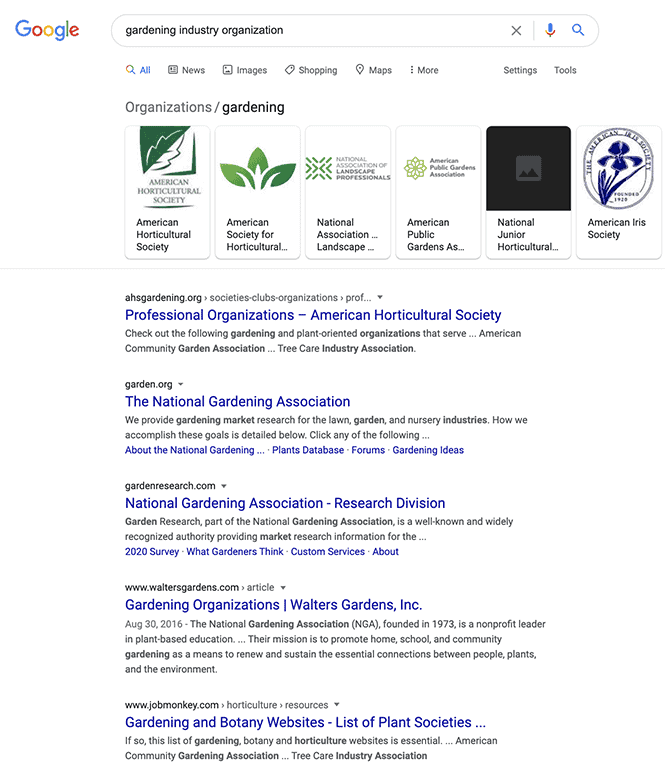
Once you’ve found a couple of industry organization sites, do the same thing you did with the magazines. Find an Editor, Managing Editor, or Marketing Manager (or the closest version of that you can), find their contact information, then send them an email sequence similar to the one we sent to the business owners.
Approach #4: Ask to write for a blog in your niche.
This is not as good as the earlier options, but it may be easier to get a clip this way.
All you do is search for:
[your industry/niche] “write for us”
Here’s what I got when I searched for “fishkeeping write for us”
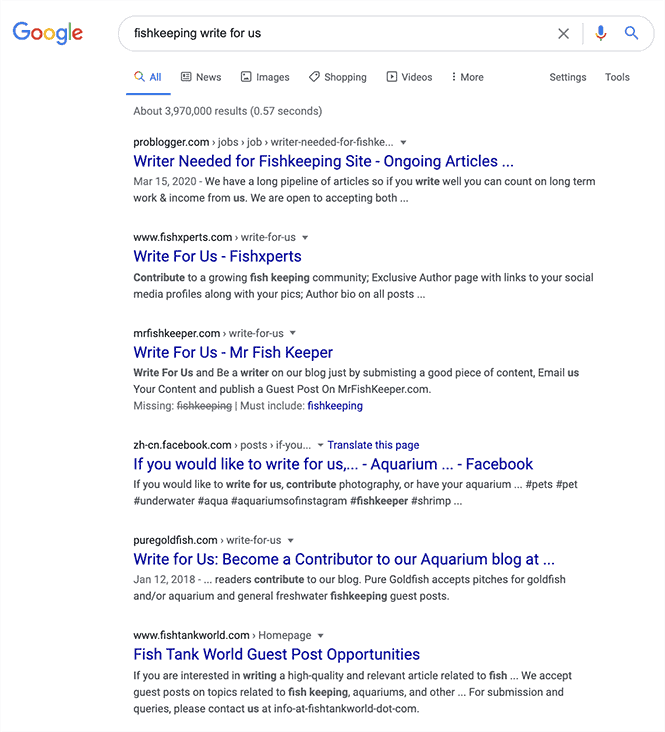
You can also vary this query by using search terms like:
Guest blog post [your niche|your industry]
Writer wanted [your niche|your industry]
It’s good to vary the terms you use for your industry. So instead of “fishkeeping,” I could have used “aquarium hobby,” or “aquascaping,” or “aquariums write for us.”
You get the idea. If you know how to look, there are probably over a dozen different places you can find to get your first clips at.
You don’t need more than three writing samples to get started
Getting three good clips published may take several weeks of work if you’ve only got a few hours a week to build your content writing business. It can feel like slow progress, but keep going and produce the very best clips you get. Then get at least one more published on the best site you can.
Three clips is enough to start sending cold emails out. It’s also enough to fill out a LinkedIn profile so you look like a real, live, professional writer. And if you have a website, three articles is enough to fill up a page reasonably well, especially if you include a two to three-sentence summary of each writing sample and include an image and a bit about where the piece was published.
Definitely stop when you have five clips like this. You do not need more than five clips, and we don’t want you doing any more free work than you absolutely have to. This part of getting your writing business set up is over. Now it’s time for client outreach.


